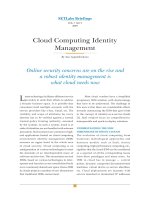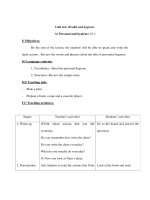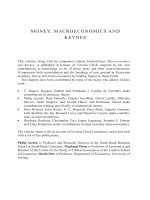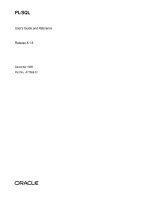Cloud Computing Implementation Management and Security phần 1 potx
Bạn đang xem bản rút gọn của tài liệu. Xem và tải ngay bản đầy đủ của tài liệu tại đây (881.82 KB, 34 trang )
Cloud
Computing
K10347_FM.indd 1 7/8/09 4:20:38 PM
K10347_FM.indd 2 7/8/09 4:20:38 PM
Cloud
Computing
Implementation,
Management,
and Security
John W. Rittinghouse
James F. Ransome
CRC Press is an imprint of the
Taylor & Francis Group, an informa business
Boca Raton London New York
K10347_FM.indd 3 7/8/09 4:20:38 PM
CRC Press
Taylor & Francis Group
6000 Broken Sound Parkway NW, Suite 300
Boca Raton, FL 33487-2742
© 2010 by Taylor and Francis Group, LLC
CRC Press is an imprint of Taylor & Francis Group, an Informa business
No claim to original U.S. Government works
Printed in the United States of America on acid-free paper
10 9 8 7 6 5 4 3 2 1
International Standard Book Number: 978-1-4398-0680-7 (Hardback)
This book contains information obtained from authentic and highly regarded sources. Reasonable
efforts have been made to publish reliable data and information, but the author and publisher cannot
assume responsibility for the validity of all materials or the consequences of their use. The authors and
publishers have attempted to trace the copyright holders of all material reproduced in this publication
and apologize to copyright holders if permission to publish in this form has not been obtained. If any
copyright material has not been acknowledged please write and let us know so we may rectify in any
future reprint.
Except as permitted under U.S. Copyright Law, no part of this book may be reprinted, reproduced,
transmitted, or utilized in any form by any electronic, mechanical, or other means, now known or
hereafter invented, including photocopying, microfilming, and recording, or in any information stor-
age or retrieval system, without written permission from the publishers.
For permission to photocopy or use material electronically from this work, please access www.copy-
right.com ( or contact the Copyright Clearance Center, Inc. (CCC), 222
Rosewood Drive, Danvers, MA 01923, 978-750-8400. CCC is a not-for-profit organization that pro-
vides licenses and registration for a variety of users. For organizations that have been granted a pho-
tocopy license by the CCC, a separate system of payment has been arranged.
Trademark Notice: Product or corporate names may be trademarks or registered trademarks, and are
used only for identification and explanation without intent to infringe.
Visit the Taylor & Francis Web site at
and the CRC Press Web site at
K10347_FM.indd 4 7/8/09 4:20:38 PM
v
Contents
Foreword xiii
Preface xix
Introduction xxv
What Is the Cloud? xxvi
The Emergence of Cloud Computing xxvi
The Global Nature of the Cloud xxvii
Cloud-Based Service Offerings xxviii
Grid Computing or Cloud Computing? xxxi
Is the Cloud Model Reliable? xxxi
Benefits of Using a Cloud Model xxxii
What About Legal Issues When Using
Cloud Models? xxxii
What Are the Key Characteristics of
Cloud Computing? xxxiv
Challenges for the Cloud xxxvi
Chapter 1 The Evolution of Cloud Computing 1
1.1 Chapter Overview 1
1.2 Hardware Evolution 2
1.2.1 First-Generation Computers 3
1.2.2 Second-Generation Computers 4
1.2.3 Third-Generation Computers 5
1.2.4 Fourth-Generation Computers 6
1.3 Internet Software Evolution 7
1.3.1 Establishing a Common Protocol for
the Internet 12
1.3.2 Evolution of Ipv6 13
RittinghouseTOC.fm Page v Monday, May 25, 2009 6:53 PM
vi Cloud Computing
1.3.3 Finding a Common Method to
Communicate Using the Internet
Protocol 13
1.3.4 Building a Common Interface to
the Internet 15
1.3.5 The Appearance of Cloud
Formations—From One Computer
to a Grid of Many 20
1.4 Server Virtualization 24
1.4.1 Parallel Processing 25
1.4.2 Vector Processing 26
1.4.3 Symmetric Multiprocessing Systems 26
1.4.4 Massively Parallel Processing Systems 27
1.5 Chapter Summary 28
Chapter 2 Web Services Delivered from the Cloud 29
2.1 Chapter Overview 29
2.2 Communication-as-a-Service (CaaS) 30
2.2.1 Advantages of CaaS 31
2.2.2 Fully Integrated, Enterprise-Class
Unified Communications 32
2.3 Infrastructure-as-a-Service (IaaS) 34
2.3.1 Modern On-Demand Computing 36
2.3.2 Amazon’s Elastic Cloud 37
2.3.3 Amazon EC2 Service Characteristics 38
2.3.4 Mosso (Rackspace) 42
2.4 Monitoring-as-a-Service (MaaS) 44
2.4.1 Protection Against Internal and
External Threats 45
2.4.2 Delivering Business Value 47
2.4.3 Real-Time Log Monitoring
Enables Compliance 48
2.5 Platform-as-a-Service (PaaS) 48
2.5.1 The Traditional On-Premises Model 49
2.5.2 The New Cloud Model 49
2.5.3 Key Characteristics of PaaS 49
2.6 Software-as-a-Service (SaaS) 50
2.6.1 SaaS Implementation Issues 51
2.6.2 Key Characteristics of SaaS 52
2.6.3 Benefits of the SaaS Model 53
2.7 Chapter Summary 54
RittinghouseTOC.fm Page vi Monday, May 25, 2009 6:53 PM
Contents vii
Chapter 3 Building Cloud Networks 57
3.1 Chapter Overview 57
3.2 The Evolution from the MSP Model to Cloud
Computing and Software-as-a-Service 59
3.2.1 From Single-Purpose Architectures
to Multipurpose Architectures 60
3.2.2 Data Center Virtualization 61
3.3 The Cloud Data Center 62
3.4 Collaboration 62
3.4.1 Why Collaboration? 65
3.5 Service-Oriented Architectures as a Step
Toward Cloud Computing 70
3.6 Basic Approach to a Data Center-Based SOA 72
3.6.1 Planning for Capacity 73
3.6.2 Planning for Availability 73
3.6.3 Planning for SOA Security 74
3.7 The Role of Open Source Software in Data Centers 75
3.8 Where Open Source Software Is Used 77
3.8.1 Web Presence 78
3.8.2 Database Tier 81
3.8.3 Application Tier 83
3.8.4 Systems and Network Management Tier 87
3.9 Chapter Summary 101
Chapter 4 Virtualization Practicum 103
4.1 Chapter Overview 103
4.2 Downloading Sun xVM VirtualBox 104
4.3 Installing Sun xVM VirtualBox 106
4.4 Adding a Guest Operating System to VirtualBox 112
4.5 Downloading FreeDOS as a Guest OS 112
4.6 Downloading the 7-Zip Archive Tool 114
4.7 Adding a Guest OS to Sun xVM VirtualBox 115
4.8 Chapter Summary 127
Chapter 5 Federation, Presence, Identity, and Privacy in
the Cloud 129
5.1 Chapter Overview 129
5.2 Federation in the Cloud 129
5.2.1 Four Levels of Federation 132
RittinghouseTOC.fm Page vii Monday, May 25, 2009 6:53 PM
viii Cloud Computing
5.2.2 How Encrypted Federation Differs
from Trusted Federation 134
5.2.3 Federated Services and Applications 134
5.2.4 Protecting and Controlling Federated
Communication 135
5.2.5 The Future of Federation 136
5.3 Presence in the Cloud 136
5.3.1 Presence Protocols 137
5.3.2 Leveraging Presence 138
5.3.3 Presence Enabled 139
5.3.4 The Future of Presence 139
5.3.5 The Interrelation of Identity, Presence,
and Location in the Cloud 140
5.3.6 Federated Identity Management 140
5.3.7 Cloud and SaaS Identity Management 141
5.3.8 Federating Identity 143
5.3.9 Claims-Based Solutions 144
5.3.10 Identity-as-a-Service (IaaS) 144
5.3.11 Compliance-as-a-Service (CaaS) 145
5.3.12 The Future of Identity in the Cloud 146
5.4 Privacy and Its Relation to Cloud-Based
Information Systems 147
5.4.1 Privacy Risks and the Cloud 149
5.4.2 Protecting Privacy Information 150
5.4.3 The Future of Privacy in the Cloud 151
5.5 Chapter Summary 152
Chapter 6 Security in the Cloud 153
6.1 Chapter Overview 153
6.2 Cloud Security Challenges 158
6.3 Software-as-a-Service Security 162
6.3.1 Security Management (People) 164
6.3.2 Security Governance 165
6.3.3 Risk Management 165
6.3.4 Risk Assessment 165
6.3.5 Security Portfolio Management 166
6.3.6 Security Awareness 166
6.3.7 Education and Training 167
6.3.8 Policies, Standards, and Guidelines 167
6.3.9 Secure Software Development
Life Cycle (SecSDLC) 168
RittinghouseTOC.fm Page viii Monday, May 25, 2009 6:53 PM
Contents ix
6.3.10 Security Monitoring and Incident
Response 169
6.3.11 Third-Party Risk Management 169
6.3.12 Requests for Information and Sales
Support 169
6.3.13 Business Continuity Plan 170
6.3.14 Forensics 170
6.3.15 Security Architecture Design 172
6.3.16 Vulnerability Assessment 173
6.3.17 Password Assurance Testing 173
6.3.18 Logging for Compliance and Security
Investigations 173
6.3.19 Security Images 173
6.3.20 Data Privacy 174
6.3.21 Data Governance 175
6.3.22 Data Security 175
6.3.23 Application Security 176
6.3.24 Virtual Machine Security 177
6.3.25 Identity Access Management (IAM) 177
6.3.26 Change Management 178
6.3.27 Physical Security 178
6.3.28 Business Continuity and Disaster
Recovery 179
6.3.29 The Business Continuity Plan 180
6.4 Is Security-as-a-Service the New MSSP? 181
6.5 Chapter Summary 182
Chapter 7 Common Standards in Cloud Computing 183
7.1 Chapter Overview 183
7.2 The Open Cloud Consortium 183
7.3 The Distributed Management Task Force 185
7.3.1 Open Virtualization Format 186
7.4 Standards for Application Developers 187
7.4.1 Browsers (Ajax) 188
7.4.2 Data (XML, JSON) 189
7.4.3 Solution Stacks (LAMP and LAPP) 192
7.5 Standards for Messaging 193
7.5.1 Simple Message Transfer
Protocol (SMTP) 193
7.5.2 Post Office Protocol (POP) 194
RittinghouseTOC.fm Page ix Monday, May 25, 2009 6:53 PM
x Cloud Computing
7.5.3 Internet Messaging Access
Protocol (IMAP) 194
7.5.4 Syndication (Atom, Atom Publishing
Protocol, and RSS) 194
7.5.5 Communications (HTTP, SIMPLE,
and XMPP) 202
7.6 Standards for Security 205
7.6.1 Security (SAML OAuth, OpenID,
SSL/TLS) 205
7.7 Chapter Summary 212
Chapter 8 End-User Access to Cloud Computing 213
8.1 Chapter Overview 213
8.2 YouTube 214
8.3 YouTube API Overview 215
8.3.1 Widgets 216
8.3.2 YouTube Player APIs 217
8.3.3 The YouTube Custom Player 218
8.3.4 YouTube Data API 218
8.4 Zimbra 219
8.4.1 Zimbra Collaboration Suite (ZCS) 221
8.5 Facebook 221
8.5.1 Facebook Development 223
8.6 Zoho 223
8.6.1 Zoho CloudSQL 225
8.7 DimDim Collaboration 226
8.8 Chapter Summary 233
Chapter 9 Mobile Internet Devices and the Cloud 235
9.1 Chapter Overview 235
9.2 What Is a Smartphone? 236
9.3 Mobile Operating Systems for Smartphones 237
9.3.1 iPhone 237
9.3.2 Google (Android) 237
9.3.3 Blackberry 241
9.3.4 Windows Mobile 241
9.3.5 Ubuntu Mobile Internet Device (MID) 243
9.4 Mobile Platform Virtualization 251
9.4.1 KVM 253
9.4.2 VMWare 254
9.5 Collaboration Applications for Mobile Platforms 256
RittinghouseTOC.fm Page x Monday, May 25, 2009 6:53 PM
Contents xi
9.6 Future Trends 257
9.7 Chapter Summary 258
9.8 Closing Comments 258
Appendix A Virtualization Practicum (Linux) 261
A.1 Overview 261
A.2 Adding a Linux-Based Guest Operating System
to VirtualBox 262
A.3 Downloading OpenSolaris as a Guest
Operating System 263
A.4 Using the 7-Zip Archive Tool 264
A.5 Adding the OpenSolaris Guest OS to Sun
xVM VirtualBox 265
A.6 Summary 281
Appendix B Executive Scenario for Cloud Migration 285
Index 297
RittinghouseTOC.fm Page xi Monday, May 25, 2009 6:53 PM
RittinghouseTOC.fm Page xii Monday, May 25, 2009 6:53 PM
xiii
Foreword
While there is no arguing about the staying power of the cloud model and
the benefits it can bring to any organization or government, mainstream
adoption depends on several key variables falling into alignment that will
provide users the reliability, desired outcomes, and levels of trust necessary
to truly usher in a “cloud revolution.” Until recently, early adopters of cloud
computing in the public and private sectors were the catalyst for helping
drive technological innovation and increased adoption of cloud-based strat-
egies, moving us closer to this inevitable reality. Today, driven in large part
by the financial crisis gripping the global economy, more and more organi-
zations are turning toward cloud computing as a low-cost means of deliver-
ing quick-time-to-market solutions for mission-critical operations and
services. The benefits of cloud computing are hard to dispute:
1. Reduced implementation and maintenance costs
2. Increased mobility for a global workforce
3. Flexible and scalable infrastructures
4. Quick time to market
5. IT department transformation (focus on innovation vs. mainte-
nance and implementation)
6. “Greening” of the data center
7. Increased availability of high-performance applications to small/
medium-sized businesses
Gartner, in a February 2, 2009, press release, posed the question of
why, when “the cloud computing market is in a period of excitement,
growth and high potential. . . [we] will still require several years and many
Foreword.fm Page xiii Friday, May 22, 2009 11:23 AM
xiv Cloud Computing
changes in the market before cloud computing is a mainstream IT effort”?
1
In talking with government and industry leaders about this, it became clear
that the individual concerns and variables that were negatively impacting
business leaders’ thought processes regarding cloud computing (and there-
fore preventing what could be even more growth in this market) could be
boiled down to one addressable need: a lack of understanding. Let’s take this
case in point: GTRA research showed that the most common concern about
implementing cloud programs was security and privacy, a finding supported
by an IDC study of 244 CIOs on cloud computing, in which 75% of
respondents listed security as their number-one concern.
2
It is true that
moving from architectures that were built for on-premises services and
secured by firewalls and threat-detection systems to mobile environments
with SaaS applications makes previous architectures unsuitable to secure
data effectively. In addition, at a March 2009 FTC meeting discussing cloud
computing security and related privacy issues, it was agreed that data man-
agement services might experience failure similar to the current financial
meltdown if further regulation was not implemented. In short, some execu-
tives are simply too scared to move forward with cloud initiatives.
However, this concern, while valid, is not insurmountable. Already
there are countless examples of successful cloud computing implementa-
tions, from small organizations up to large enterprises that have low risk tol-
erance, such as the U.S. Department of the Navy. The security community
is also coming together through various initiatives aimed at education and
guidance creation. The National Institute of Standards and Technologies
(NIST) is releasing its first guidelines for agencies that want to use cloud
computing in the second half of 2009, and groups such as the Jericho forum
are bringing security executives together to collaborate and deliver solutions.
As with any emerging technology, there exists a learning curve with regard
to security in a cloud environment, but there is no doubt that resources and
case studies exist today to help any organization overcome this.
The same types of pros and cons listed above can be applied to other
concerns facing executives, such as data ownership rights, performance,
and availability. While these are all valid concerns, solutions do exist and
are being fine-tuned every day; the challenge is in bringing executives out
of a state of unknown and fear and giving them the understanding and
1. “Cloud Application Infrastructure Technologies Need Seven Years to Mature,” Gartner, Inc.,
December 2008.
2. “IT Cloud Services User Study,” IDC, Inc., October 2008.
Foreword.fm Page xiv Friday, May 22, 2009 11:23 AM
Foreword xv
knowledge necessary to make informed, educated decisions regarding
their cloud initiatives.
In this book, Drs. Rittinghouse and Ransome do a tremendous job of
educating, dispelling myths, and giving detailed examples and steps which
will provide the reader with a proper understand of cloud computing, its
risks, and how to implement and manage an effective cloud strategy. This is
all done is a manner that is reader-friendly but with enough detailed techni-
cal language to be complete, and not so much that a nontechnical leader
will be lost.
In the Introduction and Chapter 1, Drs. Rittinghouse and Ransome lay
the foundation for the reader’s proper understanding of cloud computing,
detailing its history and evolution and discussing how new technologies
such as virtualization played a huge role in the growth and acceptance of
cloud computing. Chapter 2 then educates us on the different types of ser-
vices which can be delivered from the cloud, providing detail on Software-
as-a-Service (SaaS), Infrastructure-as-a-Service (IaaS), Platform-as-a-Service
(PaaS), Monitoring-as-a-Service (MaaS), and Communication-as-a-Service
(CaaS).
Chapter 3 dives into the heart of what it means to build a cloud net-
work, including a look at the roles that service-oriented architecture (SOA
and open source software play in the process. Following this, Chapter 4 is
dedicated entirely to the topic of virtualization, a critical component of
any cloud network and one of the technologies which is a foundation of
cloud concepts.
Security and privacy, one of the largest areas of concern for anyone
building a cloud network, are covered in Chapters 5 and 6. These chapters
look at how federation in the cloud and federated services and applications
can be used to increase security, build trust, and mitigate risk. Dr. Ron Ross,
a senior computer scientist at NIST, recently said, “You’re never going to
have complete trust. We don’t live in a risk-free environment—we have to
manage risk, not avoid it.” These chapters give the reader a wealth of guid-
ance, practical applications, and process, which can be used to keep risk at
an acceptable level in any cloud network.
Chapter 7 shifts focus to look at common standards in cloud comput-
ing, including standards for application development, messaging, and secu-
rity. Social networking and collaboration is the focus of Chapter 8, in which
the authors discuss end-user access to cloud computing (You Tube, Face-
book, etc.). Chapter 9, the book’s final chapter, discusses in detail how
Foreword.fm Page xv Friday, May 22, 2009 11:23 AM
xvi Cloud Computing
mobile Internet devices react with cloud networks—a topic which is critical
now and will only increase in importance as users expect more and more
applications to be delivered to their smartphones and other mobile devices.
We feel that completing this book, readers will have a thorough, well-
rounded understanding of cloud computing, the knowledge necessary to
overcome fears, and will be armed with the guidance necessary to make
smart, strategic decisions regarding their cloud initiatives. Ultimately, this
book will play a part in ushering in the “cloud revolution” and will help
overcome the lack of understanding currently preventing even faster adop-
tion of cloud computing.
Kelly Yocum
Parham Eftekhari
Co-Founders, Government Technology Research Alliance
Kelly Yocum and Parham Eftekhari are the co-founders of the Government
Technology Research Alliance (GTRA), an organization that provides gov-
ernment CXO leaders a forum in which to collaborate, strategize, and create
innovative solutions for today’s most pressing IT needs. Kelly is GTRA’s
executive director and is responsible for strategic direction, business devel-
opment, and work with solution and technology providers for the GTRA
Government Council. She also serves as the CEO for GOVTek, a collabora-
tive online information resource for government technology executives and
industry experts. Kelly was formerly CEO of ConVurge, a business intelli-
gence conference company, where she founded several councils for govern-
ment technology including SecureGOV, ArchitectureGOV, MobileGOV,
and HrGOV, which are currently managed by GTRA. She invented a
unique government-to-industry collaboration model, called GTRA Round-
table Meetings, which foster an innovative discussion forum for government
and industry experts.
Parham Eftekhari serves as director of research and curriculum develop-
ment for GTRA, where he is responsible for overseeing all research con-
ducted with senior government technology executives and industry leaders
on technology and leadership issues. Parham’s areas of expertise include
transparency/open government, enterprise architecture, security, virtualiza-
tion, information sharing, social networking/Web 2.0, knowledge manage-
ment, green IT, records management, mobility, and cloud computing.
Foreword.fm Page xvi Friday, May 22, 2009 11:23 AM
Foreword xvii
Parham is also responsible for growing GTRA’s councils with key govern-
ment leaders and assisting in the government-to-industry collaboration
model. Parham is also vice president of GOVTek, where his primary focus is
to oversee the content, research, and resources shared on the site. Parham
formerly served as director of technology research for Proactive Worldwide,
managing the full life cycle of competitive intelligence, strategic, and market
assessment research studies. Together, Parham and Kelly run the semiannual
GTRA Council Meeting Symposia, which bring together executive-level
decision makers from both the public and private sectors to collaborate,
share ideas, and discuss solutions to current challenges. This forum is a
unique model for government and technology collaboration in which the
concepts of cloud computing and the cloud’s value to the next generation of
consumers and practitioners in both government and commercial sectors
are presented.
Foreword.fm Page xvii Friday, May 22, 2009 11:23 AM
Foreword.fm Page xviii Friday, May 22, 2009 11:23 AM
xix
Preface
There are lots of books on cloud computing in the market today. This one is
not intended for “supergeeks” looking for the next revelation in “geek
know-how.” In fact, it attempts to present cloud computing in a way that
anyone can understand. We do include technical material, but we do so in a
way that allows managers and technical people alike to understand what
exactly cloud computing is and what it is not. We try to clear up the confu-
sion about current buzzwords such as PaaS, SaaS, etc., and let the reader see
how and why the technology has evolved to become “the cloud” as we know
and use it today.
In the Introduction we explain what cloud computing is, its charac-
teristics, and the challenges it will face in the future. The biggest chal-
lenges that companies will face as they move into the cloud are secure data
storage, high-speed access to the Internet, and standardization. Storing
large amounts of data in centralized locations while preserving user pri-
vacy, security, identity, and their application-specific preferences raises
many concerns about data protection. These concerns, in turn, lead to
questions about the legal framework that should be implemented for a
cloud-oriented environment.
In Chapter 1 we discuss the evolution of cloud computing, including
hardware, software, and server virtualization. In order to discuss some of the
issues involved in the cloud concept, it is important to place the develop-
ment of computational technology in a historical context. Looking at the
cloud’s evolutionary development, and the problems encountered along the
way, provides some key reference points to help us understand the chal-
lenges that had to be overcome by those who were responsible for the devel-
opment of the Internet and the World Wide Web. These challenges fell into
three primary categories: hardware, software, and virtualization. We discuss
how the rules computers use to communicate came about, and how the
Preface.fm Page xix Friday, May 22, 2009 11:24 AM
xx Cloud Computing
development of networking and communications protocols helped drive the
technology growth we have seen in the last two decades or so. This, in turn,
has driven even more changes in protocols and forced the creation of new
technologies to mitigate concerns and improve the methods used to com-
municate over the Internet. The rise of web browsers led to huge growth in
use of the Internet and a migration away from the traditional data center
toward cloud computing.
In Chapter 2 we discuss the advent of web-based services delivered
from the cloud, including Communication-as-a-Service (CaaS), Infrastruc-
ture-as-a-Service (IaaS), Monitoring-as-a-Service (MaaS), Platform-as-a-
Service (PaaS), and Software-as-a-Service (SaaS). As technology has
migrated from the traditional on-premises model to the new cloud model,
service offerings have evolved almost daily. We provide some basic exposure
to where the technology is today, and we give you a feel for where it will
likely be in the not too distant future.
In Chapter 3 we discuss what is required from service providers to
make the services described in Chapter 2 available. We describe the basic
approach to service-oriented architecture (SOA) as it applies to data center
design, how companies can build highly automated private cloud networks
that can be managed from a single point, and how server and storage virtu-
alization is used across distributed computing resources. We discuss what it
takes to build a cloud network, the evolution from the managed service pro-
vider model to cloud computing and SaaS and from single-purpose archi-
tectures to multipurpose architectures, the concept and design of data
center virtualization, the role and importance of collaboration, SOA as an
intermediate step and the basic approach to data center-based SOA, and
lastly, the role of open source software in data centers and where and how it
is used in the cloud architecture.
In Chapter 4 we provide a virtualization practicum that guides you
through a step-by-step process for building a virtualized computing infra-
structure using open source software. The beauty of virtualization solutions
is that you can run multiple operating systems simultaneously on a single
computer. So that you could really understand how powerful that capability
is, we show you how to do it for yourself. We show you how to download
and install the Sun VirtualBox, how to install and configure it, and how to
add a virtual operating environment on top of your existing operating sys-
tem. In learning the basics of using the Sun xVM VirtualBox, you will also
gain knowledge about what virtualization is and how it can be used.
Preface.fm Page xx Friday, May 22, 2009 11:24 AM
Preface xxi
Chapter 5 discusses the importance and relevance of federation, pres-
ence, identity, and privacy in cloud computing and the latest challenges,
solutions, and potential future for each in the cloud. Building a seamless
federated communications capability in a cloud environment, one that is
capable of supporting people, devices, information feeds, documents, appli-
cation interfaces, and other entities, depends on the architecture that is
implemented. The solution chosen must be able to find such entities, deter-
mine their purpose, and request presence data so that others can interact
with them in real time. This process is known as discovery.
The extension of virtualization and virtual machines into the cloud is
affecting enterprise security because the traditional enterprise network
perimeter is evaporating. In Chapter 6 we identify security as the greatest
challenge in cloud computing, particularly with regard to the SaaS environ-
ment. Although there is a significant benefit to leveraging cloud computing,
security concerns have led some organizations to hesitate to move critical
resources to the cloud.
Corporations and individuals are concerned about how security and
compliance integrity can be maintained in this new environment. Even
more concerning, though, is the corporations that are jumping to cloud
computing while being oblivious to the implications of putting critical
applications and data in the cloud. Chapter 6 addresses the security con-
cerns of the former and educates the latter. Moving critical applications and
sensitive data to a public and shared cloud environment is a major concern
for corporations that are moving beyond their data center’s network perime-
ter defense. To alleviate these concerns, a cloud solution provider must
ensure that customers can continue to have the same security and privacy
controls over their applications and services, provide evidence to these cus-
tomers that their organization and customers are secure and they can meet
their service-level agreements, and show how can they prove compliance to
their auditors.
Regardless of how the cloud evolves, it needs some form of standardiza-
tion so that the market can evolve and thrive. Standards also allow clouds to
interoperate and communicate with each other. In Chapter 7 we introduce
some of the more common standards in cloud computing. Although we do
not analyze each standard in depth, you should gain a feel for how and why
each standard is used and, more important, a better understanding of why
they evolved. Most current standards evolved from necessity, as individuals
took a chance on new innovation. As these innovative techniques became
Preface.fm Page xxi Friday, May 22, 2009 11:24 AM
xxii Cloud Computing
acceptable to users and implementers, more support for the technique
ensued. At some point, the innovation began to be considered a “standard,”
and groups formalized protocols or rules for using it. We discuss the Open
Cloud Consortium and the Distributed Management Task Force as exam-
ples of cloud-related working groups.
Innovation leading to success in cloud services depends ultimately on
acceptance of the application by the user community. In Chapter 8 we
present some of the applications that are gaining acceptance among end
users. We look at some of the most popular SaaS offerings for consumers
and provide an overview of their benefits and why, in our opinion, they are
helping to evolve our common understanding of what collaboration and
mobility will ultimately mean in our daily lives. We examine five particu-
larly successful SaaS offerings, YouTube, Zimbra, Facebook, Zoho, and
DimDim, looking at them from both the user perspective and the devel-
oper/implementer perspective. This dual perspective should give you a clear
understanding of how such offerings are transforming our concept of com-
puting by making much traditional desktop-type software available from
the cloud.
In Chapter 9 we detail the transition from fixed devices connected to
the Internet to the new mobile device–empowered Internet. While it is
essentially the same Internet, it has become tremendously more accessible,
and advances in telephony, coupled with the use of the Internet, have led to
some very compelling, powerful offerings. In this chapter we provide an
overview of the more common offerings and how their widespread use will
affect the cloud computing world. When more than 90% of your user base
depends on mobile devices for common applications such as email, con-
tacts, and media streaming or sharing, you cannot take the same approach
as you used with statically connected Internet devices such as laptops and
desktop PCs. It is a brave, new cloud-based world we are entering.
We hope that what you take away from reading this book is knowledge
that separates hype from reality in talking about cloud computing. It seems
that everyone you ask has a different answer. Most of the time, each answer
you hear is based on one person’s experience with the cloud or with his or
her desire to capitalize on the cloud for profit. Our intent is to present the
cloud as an evolving, changing entity that does so out of demand from the
Internet community itself. The technologies that are used in the cloud often
give rise to new uses. For example, 10 years ago, you needed custom appli-
cations to watch video, the right codec had to be used for the right software,
Preface.fm Page xxii Friday, May 22, 2009 11:24 AM
Preface xxiii
etc. It was more trouble than watching the video was worth. Today, there is
a
de facto
standard. Look at how YouTube has come about as a result of such
innovation. After you read this book, you will know about the cloud, but
not from the perspective of any one source; you will know from the perspec-
tive of how technological innovation has actually made it what it is.
Preface.fm Page xxiii Friday, May 22, 2009 11:24 AM
Preface.fm Page xxiv Friday, May 22, 2009 11:24 AM









